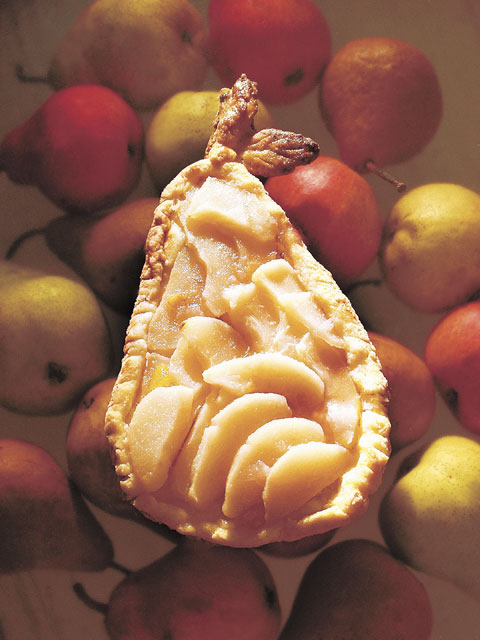Pear-shaped Desserts, According to Erik Satie by Lucie Renaud
/ July 1, 2002
Version française...
Photo: Russell Proulx
With the return of warmer days and the
bounty of summer crops, gourmets will tend to favour simple delicious desserts.
This month, we therefore recommend three desserts inspired by Erik Satie's 1903
piano composition Trois morceaux en forme de poire:
a pear sherbet, pears poached in red wine and a pear galette. Depending on your inspiration you might choose
to make only one or you could offer your guests the whole trio, made up of a
poached Japanese pear (much smaller), a mini biscuit-cake (taking special care
to cut the pear into smaller pieces) and a serving of sherbet using a melon
spoon.

Satie and the Joy of Eating
Certainly a highly
extravagant composer known for his wit and inimitable puns, Satie, judging from
his correspondence, enjoyed an ambiguous relationship with the culinary arts. In
an article dealing with the topic, "The art of the table" (mentioned in the
writings collected by Ornella Volta, the great specialist of the velvet
gentleman) he wrote: "Personally I have always had the greatest admiration, an
unbounded admiration actually, for the culinary arts. I am far from indifferent
to a good meal. I would even say that I have a sort of respect for it, and maybe
more [...] For me, eating is naturally a duty--a pleasant, festive duty--and I
really want to perform this duty with exactitude and due attention. My appetite
is good and I eat for myself, without selfishness or the urge to wolf things
down. In other words, 'My posture is better at a table than on horseback'--even
though I ride rather well. [...] During a meal I play a central role: I am a
table guest just as at the theatre some people are spectators. Yes... the
spectator has a well-defined role: he listens and sees; the guest eats and
drinks. In a way it's the same thing--in spite of all the differences between
the two roles.
"Dishes that
require a calculated virtuosity or a discriminating science to make are not the
ones that hold my 'taste' attention. In art, I love
simplicity just as I do in food. I will applaud the well-done roast more than
the meat lost under the ingenious layers made by a sauce master--if you don't
mind my saying so."
"Trois morceaux en forme de poire"
In 1903, Satie
composed a piano piece for four hands entitled "Trois
morceaux en forme de poire avec une manière de commencement, une prolongation du
même et un en plus, suivi d'une redite," which despite the title is actually
five pieces. For Satie, the number three had a predominant importance: it was a
sort of golden mean. All of the Master of Arcueil's humorous period works come
in threes. Anne Rey explains in Satie, published in
Seuil's Solfèges collection: "It has been proven that Satie related the
symbolism of the number three to a specific way of making music and listening to
it in an attitude that must be qualified as mystical."
Pear Sherbet
We have already
presented this recipe in our La cena musicale column
dealing with "Pears Belle-Hélène" in March 2002.
Pears Poached in Red Wine (for 3)
Bring 450 ml (2
cups) of Merlot (or any other fruity red wine) and 75 ml (1/3 cup) of sugar to a
simmer. Peel and core (a melon spoon can be handy here) three ripe but firm
pears (Bosc, Bartlett or Anjou), preserving the stem. Carefully place them in
the liquid. Cover and poach the fruit on low heat for 10 to 20 minutes,
depending on the pears. Remove the pears from the liquid. Bring the liquid to a
quick boil until syrup forms (about 10 minutes). To serve, warm the pears in the
syrup, place them in serving dishes and pour a little syrup over
them.
Pear galette (for 6)
Ingredients
- 115 g (1 cup)
flour
- 5 ml (1
teaspoon) sugar
- a pinch of
salt
- 75 ml (5
tablespoons) cold unsalted butter
- 1 egg
- 5 ml (1
teaspoon) milk
- Apricot, pear
or peach jam
- 3 or 4
pears
- 30 ml (2
tablespoons) melted butter
The oldest of all
pastries according to the Larousse gastronomique,
made primarily in the French countryside, this biscuit-cake is baked without a
mould. You can give it any shape you want (why not try a pear shape?). This
preparation can be warmed up a little before being served, (recipe adapted from
Classic Home Desserts by Richard Sax, Chapters
Publishing, 1994).
Galette: In a food
processor or in a bowl, mix the flour, sugar and salt. Incorporate the butter
cut up into small pieces. Beat 1 egg and 5 ml of milk in a cup. Pour about half
the whipped egg on the flour, sugar and salt preparation and shape into a ball.
It should be sticky. Refrigerate in wax paper for approximately 30
minutes.
On a floured
surface, spread out the dough into a 25-cm circular (or any other) shape. Place
the dough on a buttered metal plate. Fold up the edge of the dough about 1/2 cm.
Groove the edges and apply a little whipped egg. With a brush, spread a layer of
apricot, pear or peach jam on the bottom of the biscuit cake. Refrigerate the
dough while you prepare the pears.
Pears: Peel, slice
into quarters and core 3 or 4 pears. Slice each of the quarters into 5 or 6
sections.
Assembly: Lay out
the pear slices on the biscuit-cake, making sure to keep 6 of them to decorate
the centre of the cake. Using a brush, apply the melted butter on the pears and
dust with a little sugar. Bake in a pre-heated oven at 200 oC (425 F) for 25 to 30 minutes, until the crust is
golden brown and the pears are tender. [Translated by
Alexandre Lebedeff]
Version française... | 

